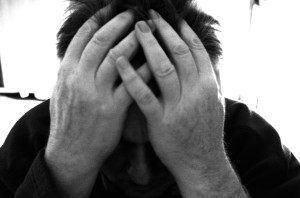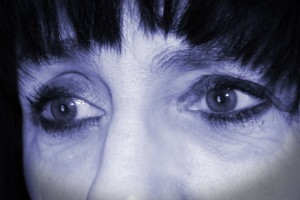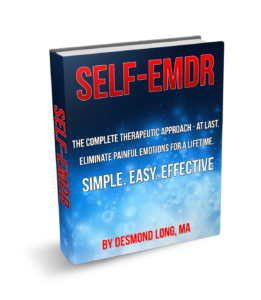What Can Go Wrong?
Although the most important consideration with Self-EMDR is safety, safety, safety – several reports have come in about problems. Every one has been evaluated and removed.
Mary was a teenage mother, estranged from her family and living in a flat with her baby. The child’s father did not like babies (“Dirty things”) and so departed with another lady. Bravely, Mary battled on until, unexpectedly, the baby died of SIDS (Sudden Infant Death Syndrome).
Mary procured a copy of my book but reportedly was “unable to eliminate or substantially reduce the guilt and depression” within the suggested three or four one-hourly sessions. She had allowed the grief process to run its course for two months, after moving back with her parents, before attempting self-EMDR. Why the delay? I recommend this because grief is part of a natural and necessary healing process. To grieve is to heal, but unusually protracted grieving is unnecessary and undesirable.
 A brief E-mail conversation with the youngster and her mother was sufficient to establish the cause of Mary’s failure. Once entranced and reliving the shock and desperate pain she had experienced when finding the baby’s body, Mary “bailed out”. “I don’t like pain,” she said. “I’ve already had my share.” I explained that, “If you are able to tolerate as little as 40 minutes of severe discomfort, once or even twice, you will be free of the tragedy for the rest of your life. I promise.” And so it was! Mary rode the trauma down (from 10 out of 10 in terms of its intensity, to 9, to 9, to 9, to 6, to 5, to 3) over a period of 60 minutes. At that point she was aware of a huge relief, but was feeling tired and called it off until the following day.
A brief E-mail conversation with the youngster and her mother was sufficient to establish the cause of Mary’s failure. Once entranced and reliving the shock and desperate pain she had experienced when finding the baby’s body, Mary “bailed out”. “I don’t like pain,” she said. “I’ve already had my share.” I explained that, “If you are able to tolerate as little as 40 minutes of severe discomfort, once or even twice, you will be free of the tragedy for the rest of your life. I promise.” And so it was! Mary rode the trauma down (from 10 out of 10 in terms of its intensity, to 9, to 9, to 9, to 6, to 5, to 3) over a period of 60 minutes. At that point she was aware of a huge relief, but was feeling tired and called it off until the following day.
Accompanied by her fascinated – and hugely grateful – mother, the youngster did two more five-minute sets and called a halt when she could discern no further discomfort. She could remember Baby’s death, and funeral, and the black hole she had carried in her heart for weeks afterwards, but the memory itself carried no pain. 
But, but… what if the trauma went down to only five out of 10 in intensity, and stayed there? No problem. Mary would simply do more five-minute sets during the next few days until the discomfort did disappear. Failure is not possible.
What other problems can we encounter? I have had several complaints that were traced to people failing to focus, while in trance, on a single trauma. Perhaps John is over-tired when starting his Self-EMDR. His entranced mind drifts from the fact a junior member of the company has been promoted over his head (the principal trauma); to the fact he feels jealous because his wife would rather spend time with the baby than with him; to that awful noise in the car’s engine. John is supposed to hold his focus on a single trauma or area of discomfort, and keep it there, set after set, as the level of conflict falls away. If he allows his attention to drift, it simply won’t happen.
In the rare event a Self-EMDR session is completely halted, possibly because… the smoke alarm starts screaming, or the power supply fails, a potentially unfortunate situation can unfold. Hours later, or on the following day, the painful emotions that were in the process of being drained, abruptly come bursting to the surface. Although they, in turn, will recede without additional sets it can be a startling phenomenon. The obvious solution, of course, is to have another Self-EMDR session and finish draining the emotions once and for all.
Unfortunately the one problem area which is likely to capture every counselling and therapeutic modality in the world, also affects EMDR and Self-EMDR.
Because of their primal role, males tend to become aggressive when challenged (admittedly with plenty of exceptions). As a result there is an inclination for John Jo nes to blame somebody else no matter what goes wrong; even when he is obviously at fault. If he climbs out of bed on the wrong side, and you get in his face, he won’t even listen to your considered argument. He’ll be too busy searching his mind for the last word, the coup de grace.
nes to blame somebody else no matter what goes wrong; even when he is obviously at fault. If he climbs out of bed on the wrong side, and you get in his face, he won’t even listen to your considered argument. He’ll be too busy searching his mind for the last word, the coup de grace.
But the woman is different, because the human coin has two sides. She may lose an argument, because her emotions tell her that is better than damaging a relationship. He is the warrior. She is the nurturer. The Israeli Defence Force tells us their female soldiers must not be exposed to certain pivotal combat situations. She will seldom throw away her life because if she does her baby dies (again in primal terms) and there is no mother to look after the children. On the other hand, John Jones can give himself the luxury of taking a bullet and simply rolling over and dying. He has proved himself. Nothing is more important.
Now for the focus: The archetypal female will blame herself, because her role with the children demands nothing less. A male will blame the child for keeping him awake night after night. Eventually the youngster will occupy an unsafe environment. In the same situation the mother will blame herself, and frequently walk away. The child will always be in safe hands.
In the case of a severe conflict the male will defend himself by attacking. The female (especially an adolescent girl) will attack herself, sometimes by cutting. She blames herself.
It follows that a distraught women receiving EMDR or Self-EMDR is capable of holding so much self-loathing that she will (subconsciously/unconsciously/emotionally) inhibit the therapy from working without being aware of it; irrespective of the modality or technique involved.
Heads up!
(1) The above remarks are by definition a generalization, but I am convinced they are a robust generalization;
(2) EMDR and Self-EMDR enable the woman’s self-loathing to be eliminated with a small handful of sessions, in a manner that is quite impossible with any other approach.




